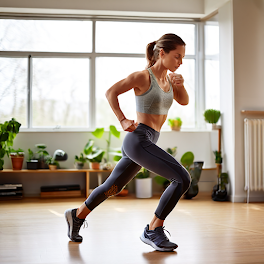Maximizing Exercise Benefits Without Intense Sweat: A Comprehensive Guide
Outline
Introduction
- Importance of exercise
- Common misconception about sweating
Understanding Exercise Intensity
- Defining exercise intensity
- Low vs. high-intensity workouts
Benefits of Low-Intensity Exercise
- Improved cardiovascular health
- Enhanced mental well-being
- Reduced risk of injury
Popular Low-Intensity Exercises
- Walking
- Yoga
- Tai Chi
- Swimming
- Cycling
Creating a Low-Intensity Exercise Routine
- Assessing your fitness level
- Setting realistic goals
- Balancing different types of exercises
Maximizing Results Without Intense Sweat
- Focus on form and technique
- Consistency over intensity
- Importance of warm-up and cool-down
Advantages of Low-Intensity Exercise
- Accessibility for all fitness levels
- Flexibility in location and time
- Sustainable long-term fitness
Disadvantages of Low-Intensity Exercise
- Slower progress in muscle building
- Potential lack of challenge for advanced athletes
Combining Low and High-Intensity Workouts
- Benefits of a mixed routine
- Sample weekly workout plan
Nutrition and Low-Intensity Exercise
- Importance of balanced diet
- Hydration tips
Tracking Your Progress
- Tools and apps for monitoring
- Setting milestones and rewards
Mental Health Benefits
- Stress reduction
- Improved mood and cognitive function
Real-Life Success Stories
- Testimonials from people who thrived with low-intensity workouts
Common Myths About Exercise and Sweat
- Debunking myths about sweating and fat loss
- Understanding body responses to exercise
Conclusion
- Summary of key points
- Encouragement to start a low-intensity exercise routine
FAQs
- Can I lose weight with low-intensity exercise?
- How often should I do low-intensity workouts?
- What is the best time of day for low-intensity exercise?
- Can I build muscle without sweating heavily?
- Are there any risks with low-intensity exercise?
Maximizing Exercise Benefits Without Intense Sweat: A Comprehensive Guide
Introduction
We all know that exercise is a cornerstone of a healthy lifestyle. It boosts our mood, improves our physical health, and can even help us live longer. But when you think of exercise, do you imagine yourself drenched in sweat, gasping for breath? Many people do. There's a common misconception that to reap the benefits of exercise, you need to push yourself to the brink. However, this isn’t necessarily true. You can maximize your exercise benefits without intense sweat sessions. This guide will show you how.
Understanding Exercise Intensity
Before diving into the benefits of low-intensity workouts, it’s essential to understand what exercise intensity means. Exercise intensity refers to how hard your body is working during physical activity. High-intensity workouts, like sprinting or heavy weightlifting, often lead to quick exhaustion and copious sweating. On the other hand, low-intensity exercises, such as walking or gentle yoga, keep your heart rate at a moderate level without leaving you drenched.
Benefits of Low-Intensity Exercise
Improved Cardiovascular Health
Engaging in low-intensity exercise regularly can significantly improve your cardiovascular health. Activities like walking or cycling enhance blood circulation, reduce blood pressure, and strengthen the heart, all without causing the intense physical strain associated with high-intensity workouts.
Enhanced Mental Well-being
Low-intensity exercises are excellent for mental health. They help reduce stress, anxiety, and depression while boosting overall mood. Activities like yoga and Tai Chi incorporate mindfulness, which further enhances mental clarity and emotional balance.
Reduced Risk of Injury
Since low-intensity exercises are less demanding on the body, they come with a lower risk of injury. They are particularly beneficial for beginners, older adults, and those recovering from injuries or surgeries.
Popular Low-Intensity Exercises
Walking
Walking is perhaps the simplest and most accessible form of exercise. It requires no special equipment and can be done almost anywhere. A brisk walk can significantly boost your health without making you sweat excessively.
Yoga
Yoga combines physical postures, breathing exercises, and meditation. It enhances flexibility, strength, and mental clarity. Various styles, from Hatha to Restorative yoga, cater to different fitness levels and preferences.
Tai Chi
Tai Chi is a form of martial arts known for its slow, deliberate movements. It improves balance, flexibility, and mental focus, making it an excellent choice for low-intensity exercise.
Swimming
Swimming is a full-body workout that is gentle on the joints. It improves cardiovascular health, muscle strength, and endurance, all while keeping you cool and sweat-free.
Cycling
Leisurely cycling is another great way to enjoy the outdoors and stay fit. It strengthens the legs and improves cardiovascular health without putting too much strain on your body.
Creating a Low-Intensity Exercise Routine
Assessing Your Fitness Level
Before starting any exercise routine, it’s crucial to assess your current fitness level. This helps in setting realistic goals and choosing appropriate exercises.
Setting Realistic Goals
Set achievable goals that align with your fitness level and lifestyle. Whether it’s walking for 30 minutes a day or attending a yoga class twice a week, having clear objectives keeps you motivated.
Balancing Different Types of Exercises
Incorporate a variety of exercises into your routine to keep things interesting and engage different muscle groups. For example, you might combine walking, yoga, and cycling throughout the week.
Maximizing Results Without Intense Sweat
Focus on Form and Technique
Proper form and technique are crucial in any exercise. They ensure that you’re engaging the right muscles and avoiding injury, making your workout more effective.
Consistency Over Intensity
Consistency is key when it comes to exercise. Regular low-intensity workouts can be just as effective, if not more so, than sporadic high-intensity sessions.
Importance of Warm-Up and Cool-Down
Always include a warm-up and cool-down in your routine. This prepares your body for exercise and aids recovery, reducing the risk of injury.
Advantages of Low-Intensity Exercise
Accessibility for All Fitness Levels
Low-intensity exercises are suitable for people of all ages and fitness levels. They are an excellent starting point for beginners and provide a gentle yet effective workout for those with more experience.
Flexibility in Location and Time
These exercises can be done almost anywhere and at any time. Whether at home, in a park, or on vacation, you can maintain your routine without much hassle.
Sustainable Long-Term Fitness
Because they are less strenuous, low-intensity exercises are easier to stick with in the long run. This sustainability is crucial for maintaining lifelong health and fitness.
Disadvantages of Low-Intensity Exercise
Slower Progress in Muscle Building
Low-intensity exercises generally do not build muscle mass as quickly as high-intensity workouts. If building muscle is a primary goal, you might need to incorporate some higher-intensity strength training.
Potential Lack of Challenge for Advanced Athletes
For those who are already fit, low-intensity workouts might not provide enough of a challenge. In such cases, a mix of low and high-intensity exercises might be more beneficial.
Combining Low and High-Intensity Workouts
Benefits of a Mixed Routine
Combining low and high-intensity workouts can offer the best of both worlds. It allows for muscle growth, cardiovascular health, and mental well-being, providing a well-rounded fitness regimen.
Sample Weekly Workout Plan
- Monday: 30 minutes of brisk walking
- Tuesday: 45 minutes of yoga
- Wednesday: 20 minutes of high-intensity interval training (HIIT)
- Thursday: Rest or light stretching
- Friday: 30 minutes of cycling
- Saturday: 30 minutes of swimming
- Sunday: 30 minutes of Tai Chi
Nutrition and Low-Intensity Exercise
Importance of Balanced Diet
A balanced diet fuels your body and enhances your exercise performance. Include a variety of fruits, vegetables, lean proteins, and whole grains in your meals.
Hydration Tips
Staying hydrated is crucial, even if you’re not sweating heavily. Drink water before, during, and after exercise to maintain optimal hydration levels.
Tracking Your Progress
Tools and Apps for Monitoring
Use fitness trackers and apps to monitor your progress. These tools can help you stay motivated and adjust your routine as needed.
Setting Milestones and Rewards
Set milestones to celebrate your progress. Rewards, like a new workout outfit or a relaxing massage, can keep you motivated.
Mental Health Benefits
Stress Reduction
Low-intensity exercises, especially those incorporating mindfulness, like yoga and Tai Chi, significantly reduce stress levels.
Improved Mood and Cognitive Function
Regular physical activity boosts endorphins, improving mood and cognitive function. It also enhances memory and focus.
Real-Life Success Stories
Hearing from people who have thrived with low-intensity workouts can be incredibly inspiring. Many have found these exercises improve their health and well-being without the strain of high-intensity routines.
Common Myths About Exercise and Sweat
Debunking Myths About Sweating and Fat Loss
Sweating is often misconceived as a sign of effective exercise and fat loss. However, sweat is simply your body’s way of cooling down and doesn’t necessarily correlate with calorie burn or fat loss.
Understanding Body Responses to Exercise
Different bodies respond to exercise in various ways. Some people sweat more due to genetics, climate, or hydration levels, not necessarily the intensity of their workout.
Conclusion
Maximizing exercise benefits doesn’t always require intense sweat sessions. Low-intensity workouts offer numerous health benefits, are accessible to all fitness levels, and are sustainable long-term. By focusing on consistency, proper form, and a balanced routine, you can achieve your fitness goals without the need for high-intensity exercises. Start your journey today and enjoy the lasting benefits of a well-rounded, low-intensity exercise routine.
FAQs
Can I lose weight with low-intensity exercise?
Yes, combining low-intensity exercise with a healthy diet can lead to weight loss. Consistency and balanced nutrition are key.
How often should I do low-intensity workouts?
Aim for at least 150 minutes of moderate-intensity exercise each week, as recommended by health guidelines.
What is the best time of day for low-intensity exercise?
The best time is whenever you feel most energetic and can fit it into your schedule consistently. Some people prefer morning walks, while others enjoy evening yoga.
Can I build muscle without sweating heavily?
Yes, muscle building is more about resistance and proper technique than sweating. Incorporate bodyweight exercises or light weights to build muscle.
Are there any risks with low-intensity exercise?
Low-intensity exercises are generally safe, but it's always a good idea to consult with a healthcare provider before starting any new exercise routine, especially if you have any health concerns.
Top On Sale Product Recommendations!
PEMF Therapy Magnetic Physiotherapy Device with 3 Modes for Health Care Water Cooling System
Price Now: USD 2713.05 (Original price: USD 3569.80, 24% off)
🔗Click & Buy: https://s.click.aliexpress.com/e/_oCMKelT















Wow.
ReplyDelete